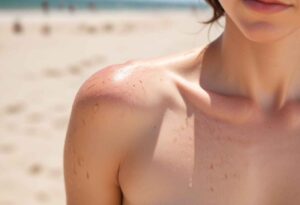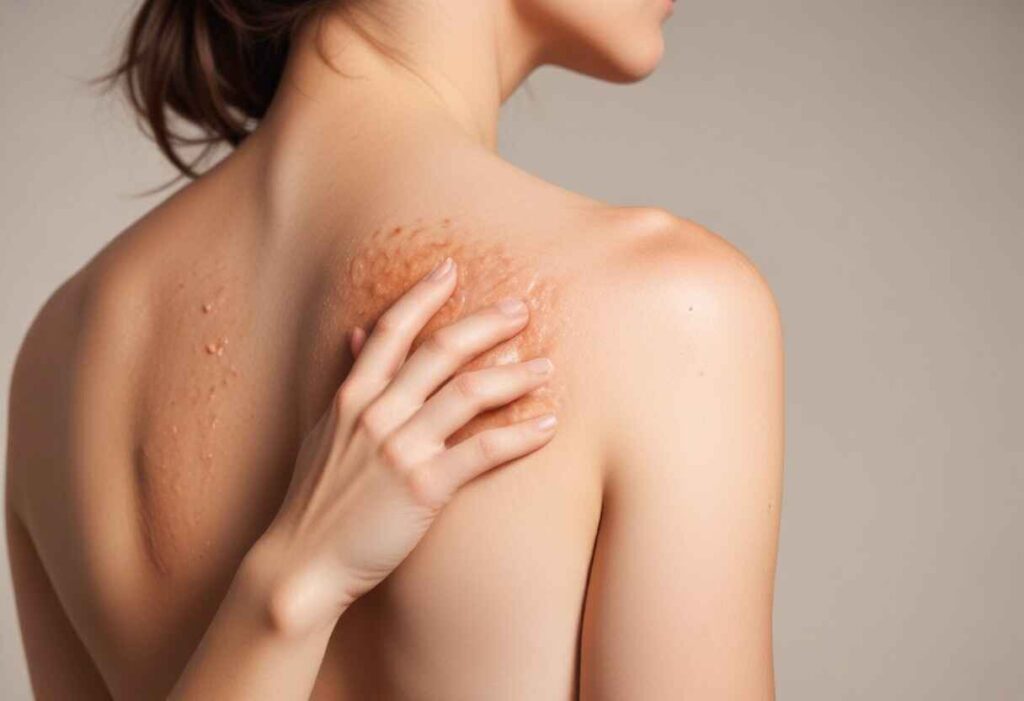Getting an itchy rash after being in the sun can be annoying and worrying. This problem, known as sun rash or polymorphic light eruption (PLE), can happen to anyone, no matter their skin type or age. Knowing what causes it, how it feels, and how to prevent it can help you deal with and avoid this bothersome condition.
What Causes Itchy Rash After Sun Exposure?
An itchy rash after being in the sun happens because the skin reacts to UV rays from the sun. Here are several explanations on why this can occur:
- Polymorphic Light Eruption (PLE): This is the most common type of sun rash. It happens when the skin reacts unusually to UV light, causing a red, itchy rash. It usually shows up a few hours to days after being in the sun and can last for several days.
- Solar Urticaria: This rare condition causes hives or raised bumps when the skin is exposed to UV or visible light. The rash can appear within minutes of sun exposure and usually goes away within hours after getting out of the sun.
- Photoallergic Reactions: These occur when a chemical on the skin, like sunscreen or fragrance, reacts with UV light and causes an allergic reaction. The rash usually appears 24 to 72 hours after being in the sun.
- Phototoxic Reactions: These are more common than photoallergic reactions. They happen when a chemical on the skin becomes harmful under sunlight, causing a rash and skin damage. Certain medicines and skincare products can cause this type of reaction.
| Cause | Description | Symptoms | Prevention/Treatment Tips |
| Polymorphic Light Eruption (PMLE) | A common sun allergy that causes red, itchy bumps or patches after sun exposure. | Red, itchy rash, typically on the neck, chest, and arms. | Gradual sun exposure, use broad-spectrum sunscreen, and wear protective clothing. |
| Sunburn | Skin damage from excessive sun exposure causing inflammation and irritation. | Red, painful, and itchy skin that may blister or peel. | Apply aloe vera, cool compresses, and use anti-inflammatory creams. |
| Photodermatitis | Abnormal skin reaction to sunlight, often triggered by medications or substances applied to the skin. | Itchy, red rash, sometimes with blisters or swelling. | Identify and avoid triggers, use broad-spectrum sunscreen, and wear protective clothing. |
| Solar Urticaria | A rare allergic reaction to sunlight causing hives and itching. | Red, raised hives that appear within minutes of sun exposure. | Avoid sun exposure, use antihistamines, and wear sun-protective clothing. |
| Heat Rash (Miliaria) | Blocked sweat glands due to excessive heat and sun exposure. | Small, itchy red bumps, often in areas covered by clothing. | Stay cool, wear loose clothing, and keep the skin dry. |
| Photoallergic Reaction | A reaction that occurs when sunlight interacts with certain chemicals in sunscreens or lotions. | Itchy, red rash that appears hours to days after sun exposure. | Use hypoallergenic products, and avoid known triggers. |
| Related: Can I Put Sunscreen on a New Tattoo |
Symptoms of Sun-Induced Itchy Rash
It’s important to recognize the signs of an itchy rash caused by the sun so you can treat it quickly. Common symptoms include:
- Redness and Swelling: The area that is affected often turns red and swollen.
- Itching and Burning: The rash usually comes with strong itching and a burning feeling.
- Blisters or Bumps: Sometimes, small blisters or bumps can appear on the skin.
- Dry or Flaky Skin: As the rash heals, the skin may become dry and flaky.

Preventing Itchy Rash After Sun Exposure
To prevent itchy rashes from the sun, you need to protect your skin from too much UV exposure. Here are a few simple methods for handling that:
- Use Sunscreen: Put on sunscreen that protects against both UVA and UVB rays, with at least SPF 30. Every two hours, or more frequently if you’re sweating or swimming, reapply.
- Wear Protective Clothing: Wear long sleeves, wide-brimmed hats, and sunglasses to protect your skin from the sun. Clothes with a high ultraviolet protection factor (UPF) are especially good.
- Seek Shade: Try to stay in shaded areas, especially between 10 AM and 4 PM when the sun is strongest. Use umbrellas or portable canopies if there’s no natural shade.
- Gradual Sun Exposure: Let your skin slowly get used to being in the sun. Start with short times outside and slowly increase how long you stay in the sun over a few days.
- Avoid Certain Products: Be careful with products and medications that can make your skin more sensitive to sunlight. Ask your doctor if you’re unsure if your medications might cause this.
Treating an Itchy Rash After Sun Exposure
If you get an itchy rash after being in the sun, there are several ways to relieve the symptoms and help your skin heal:
- Cool Compresses: Place cool, damp cloths on the rash to reduce swelling and soothe itching.
- Hydration and Moisturizers: Keep your skin hydrated with gentle, fragrance-no cost moisturizers. Aloe vera gel can also help soothe the skin.
- Over-the-Counter Remedies: Use antihistamines to reduce itching and hydrocortisone cream to reduce inflammation. Follow the instructions on the package or ask a pharmacist.
- Avoid Scratching: Scratching can make the rash worse and cause infections. Keep your nails short and consider wearing gloves at night if the itching is severe.
- Stay Out of the Sun: Avoid more sun exposure until the rash is fully healed. Being in the sun again can make the symptoms worse and slow down healing.
When to See a Doctor
Most sun rashes go away on their own, but sometimes you need to see a doctor:
- Severe Symptoms: If the rash covers a large area, is very painful, or you have a fever, see a doctor right away.
- Persistent Rash: If the rash doesn’t get better after a week of treating it at home, talk to a healthcare professional.
- Signs of Infection: If the rash becomes more red, swollen, or starts oozing pus, get medical help quickly.
Conclusion
Getting an itchy rash after being in the sun can be upsetting, but you can manage it well with the right information and precautions. Protect your skin from excessive UV exposure and treat any symptoms promptly to enjoy sunny days without the discomfort of a sun rash. If you’re ever unsure, always seek advice from a doctor to ensure proper care for your skin.

